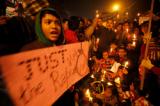
A bulletin issued this evening by the hospital said: "As at 7pm (4.30pm IST) the patient remains in an extremely critical condition. She is under treatment at Mount Elizabeth Hospital's Intensive Care Unit."
"A multi-disciplinary team of specialists is taking care of her and doing everything possible to stabilise her condition," said Dr Kelvin Loh, Chief Executive Officer of the Mount Elizabeth Hospital.
The 373-bed multi-organ transplant specialty hospital was established in 1973. One of the leading hospitals in Asia, it is known for kidney and heart transplants and receives patients from across the globe because of its state-of-the-art facilities for highly-complicated surgeries.
The young woman, who was gang-raped and brutally assaulted in a moving bus on December 16, withstood the six-hour flight from Delhi from where she was brought in an air ambulance this morning.
She underwent three surgeries at the Safdarjung Hospital in Delhi, where she remained on ventilator support during most part of the treatment. Doctors removed major part of her intestines which had become gangrenous.
Earlier, the Indian High Commission in Singapore said that the plane carrying the girl landed at the Changi International Airport here at 7.30am (5am IST). She was accompanied by her parents and a team of doctors.
The decision to shift the girl was taken at the highest level of the Indian government, which has declared that it will bear all the expenses of her treatment. he hospital and the High Commission have requested complete privacy for the patient, the parents and the doctors treating the victim.
"We have received numerous queries regarding the condition of the patient and also many offers of help. We are deeply grateful for all of these offers," the Indian mission said in a statement.
"At this stage, we would request that the privacy of the patient, family members as also of the medical team in attendance is fully respected so that the treatment may continue smoothly," the statement said.
The Indian mission has also assigned a liaison officer to the girl's parents.
The parents are accommodated in a hotel with 24-hour attachment of a liaison officer, a High Commission official told PTI.
In New Delhi, Home Minister Sushilkumar Shinde said the government would spare no effort for the treatment of the victim and it would meet all the costs for her treatment.
"We are all aware of the critical condition of victim. Since the day of the incident, it has been our endeavour to provide her the best of medical care. Despite the best efforts of our doctors, the victim continues to be critical and her fluctuating health remains a big cause of concern to all of us," he said in a statement.





Comments
Add new comment